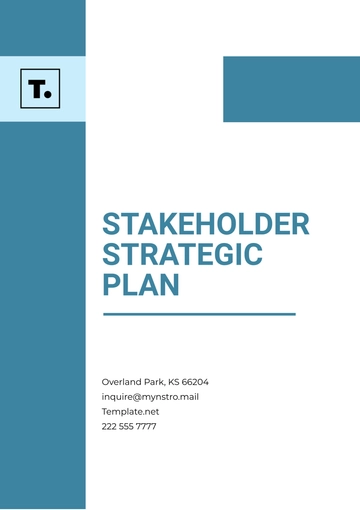Free McKinsey Design Sales Strategic Plan

Prepared By: [Your Name]
Date: March 6, 2060
I. Executive Summary
This strategic plan presents a comprehensive approach to achieving our sales objectives for the period from 2050 to 2055. By focusing on enhancing sales performance, expanding into new markets, and aligning our sales strategies with broader business goals, we aim to secure a competitive advantage and foster sustainable growth. Key initiatives will include leveraging data analytics, refining customer engagement strategies, and investing in sales training to empower our teams.
II. Market Analysis
A. Industry Overview
Current Trends: By 2050, the industry will be transforming with technological advances, shifting consumer behaviors, and economic factors. Key trends are e-commerce growth, personalized experiences, and sustainability initiatives.
Opportunities: Emerging markets, particularly in developing regions, present substantial growth opportunities. Additionally, expanding our product line to include sustainable options can attract environmentally conscious consumers.
B. Competitive Landscape
Key Competitors: Our main competitors are established brands and emerging startups innovating in products and customer engagement. We'll conduct a SWOT analysis to understand our position better.
Threats: External factors such as economic volatility, regulatory changes, and shifts in consumer preferences pose risks. Regular market monitoring and agile strategy adjustments will be essential to mitigate these threats.
III. Sales Objectives
A. Short-term Goals (2050-2052)
Market Share Growth: Increase market share by 10% in targeted regions, focusing on underperforming areas through tailored marketing and sales initiatives.
Revenue Increase: Achieve a 15% increase in sales revenue year-over-year by optimizing pricing strategies and enhancing sales processes.
B. Long-term Goals (2053-2055)
International Expansion: Successfully entered three new international markets, establishing a local presence through partnerships and localized marketing strategies.
Customer Loyalty: Develop a loyal customer base with a retention rate of 80%, achieved through enhanced customer relationship management and personalized service offerings.
IV. Customer Segmentation
A. Target Markets
Identification: Segment our customer base into distinct groups based on demographics, purchasing behavior, and preferences. This includes identifying high-value customers and niche markets.
B. Customer Needs Analysis
Deep Dive: Research each segment's needs and challenges using surveys, focus groups, and data analytics to guide product development and marketing strategies.
V. Sales Strategy and Tactics
A. Sales Approach
Consultative Selling: Adopt a consultative sales model focused on understanding customer needs and fostering long-term relationships, training teams in active listening and problem-solving.
B. Marketing Alignment
Integrated Campaigns: Work with marketing to design campaigns that connect with target audiences, using data insights to refine messages and boost engagement across channels.
VI. Resource Allocation
A. Budget Overview
Financial Planning: Allocate the budget for sales, tech, and training, prioritizing high ROI areas like digital marketing and sales tools.
B. Human Resources
Role Definition: Clearly define roles and responsibilities within the sales team. Focus on recruiting top talent with experience in consultative selling and strong customer relationship management skills.
VII. Implementation Plan
A. Timeline
Milestone Schedule:
Quarter | Milestone |
|---|---|
Q1 2050 | Complete market analysis and finalize customer segmentation. |
Q2 2050 | Launch targeted marketing campaigns and initiate training programs for sales teams. |
Q3 2051 | Conduct a performance review to evaluate the effectiveness of strategies and make necessary adjustments. |
B. Roles and Responsibilities
Team Accountability: Assign specific tasks and accountability to team members across departments, ensuring clear communication and collaboration. Establish a project management system to track progress and facilitate updates.
VIII. Performance Measurement
A. Key Performance Indicators (KPIs)
Sales Metrics: Monitor essential metrics, including:
Sales Growth Rate: Percentage increase in sales revenue over time.
Customer Acquisition Cost (CAC): Cost associated with acquiring a new customer, which should be continuously optimized.
Customer Retention Rate: Percentage of customers who continue to do business with us over a specified period.
B. Monitoring and Review
Regular Assessments: Schedule quarterly performance reviews to assess progress against objectives. Utilize dashboards and analytics tools for real-time insights, enabling timely strategy adjustments based on performance data.
- 100% Customizable, free editor
- Access 1 Million+ Templates, photo’s & graphics
- Download or share as a template
- Click and replace photos, graphics, text, backgrounds
- Resize, crop, AI write & more
- Access advanced editor
Incorporate industry-leading design into your strategy with Template.net’s McKinsey Design Sales Strategic Plan Template. Fully customizable and editable in our Ai Editor Tool, this template offers a sleek, professional format inspired by McKinsey’s strategic frameworks. It’s ideal for businesses looking to elevate their sales strategy with a visually appealing, well-structured plan.





























